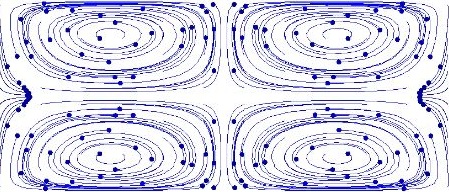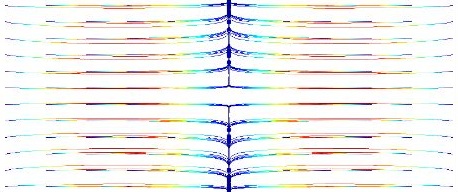
The use of acoustic waves to manipulate suspensions of particles, such as cells, has inspired the work of many researchers, paving the way for the field of ultrasound acoustofluidics. The manipulation is achieved in many ways, including using bulk acoustic waves (BAW) and surface acoustic waves (SAW), as well asacoustic radiation forcesandacoustic streaming-induced drag. The latter two combine to produce the acoustophoretic motion of the suspended particles;i.e., movement by means of sound, and the methods provide means for label-free manipulation of live cells — and at a low cost too. This is thanks to the ease of micro fabrication of lab-on-a-chip and MEMS devices and the low cost of ultrasound transducers.
A Numerical Study of Microparticle Acoustophoresis
The radiation forces act directly on the particles and occur because of momentum transfer when the acoustic field scatters on the particles (this force depends on the contrast in mechanical properties between the particle and suspending fluid). The streaming-induced drag occurs because the acoustic field interacts with the fluid and creates a stationary bulk flow. Both these effects are nonlinear and scale differently (see the difference in the results in the figures below). The processes are modeled and included in the COMSOL Multiphysics simulations presented in a paper I co-wrote with my former PhD thesis supervisor Professor H. Bruus and two of his PhD students P. B. Muller and R. Barnkob, titled “A numerical study of microparticle acoustophoresis driven by acoustic radiation forces and streaming-induced drag forces”, inLab on a Chip12, 4617–4627, (2012). Professor H. Bruus’ group works on theoretical aspects of fluid flow at the micrometer scale (microfluidics), a subset of this is acoustofluidics.
A True Multiphysics Problem Ideal for COMSOL
As we started working on how to solve the combined radiation and streaming problem, it occurred to me that this was an ideal problem to solve in COMSOL as a true multiphysics problem. The problem is handled by using functionality from theAcoustics,CFD, andParticle TracingModules.
The acoustophoresis problem is roughly solved as follows:
First, the acoustic field is solved using theThermoacoustic Interface. It is crucial to include viscosity and thermal conduction explicitly as we needed to model and resolve the thin acoustic boundary layer in detail. It is in this micrometer-thick layer that some of the nonlinear effects are strongest. TheThermoacoustic Interfacesolves the linearized Navier-Stokes, continuity, and energy equations for a compressible fluid.
Second, products of the (first order) acoustic field are used as source terms in theSingle-phase Flow Interface. Two sources emerge from the equations: one corresponds to a volumetric force and the other to a mass source.
Finally, theParticle Tracing Interfaceis used to track and model the movement of particles. Here we include both the acoustic radiation force (derived from the acoustic field) and the viscous drag from the streaming-induced background flow.
Our microparticle acoustophoresis paper clearly showcases how COMSOL can be used to solve and couple virtually any physical phenomena described by partial differential equations and a system of ordinary differential equations. The open (non-black box) nature of COMSOL allowed us to edit and modify the existing physics to fit the equations of this advanced application. This clearly makes COMSOL the ideal choice for any researcher solving non-standard problems.


Figure (click on images to animate): The motion of polystyrene particles in water in a 360 µm by 160 µm microchannel cross section. Small 0.5 µm diameter particles where the motion is governed by the streaming-induced drag (top), and large 5 µm diameter particles where the motion is governed by the acoustic radiation force (bottom).
Further Reading
- “A numerical study of microparticle acoustophoresis driven by acoustic radiation forces and streaming-induced drag forces”, in Lab on a Chip, 12, 4617–4627, P. B. Muller, R. Barnkob, M. J. Herring Jensen, and H. Bruus (2012)
- Themed Collection on Acoustofluidics from Lab on a Chip
- The work was alsopresented at the COMSOL conference in Milan in 2012



Comments (2)
Steven Tran
June 27, 2022Hello, the link for “A tutorial in 23 papers on acoustofluidics in Lab on a Chip” is not working. Is it possible to fix the link?
Rachel Keatley
June 28, 2022 COMSOL EmployeeHi Steven,
Thank you for your comment! We have updated the link and its title.
Best regards,
Rachel